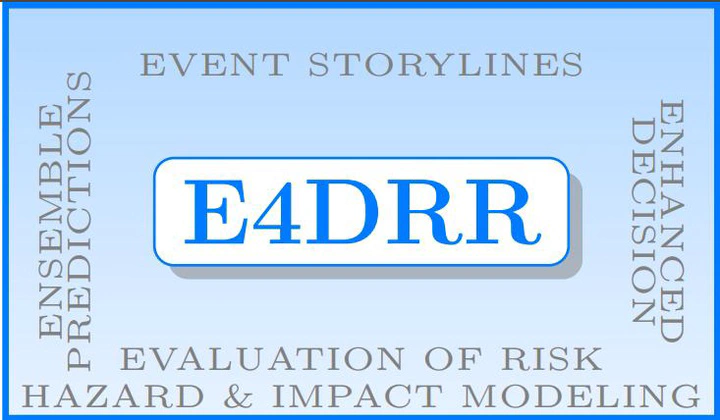Hazard modeling, impact estimation, climate storylines for event catalogue on drought and flood disasters in the Eastern Africa

Introduction:
Risk knowledge is an essential component of effective disaster risk management. The available impact data from previous disasters serve as invaluable tools for disaster preparedness and decisionmaking support. The project, titled “Hazard modeling, impact estimation, climate storylines for drought and flood disasters in Eastern Africa” in its short form “E4DRR” has been awarded funding by the Complex Risk Analytics Fund (CRAF’d). CRAF’d aims to finance, connect, and reimagine data to save lives especially in the context of leverage data to save lives and enhance disaster management globally. Supported by international partners such as the United States of America, the United Kingdom, Germany, the Netherlands, the European Commission, and the United Nations. The project is conducted at ICPAC with implementing partnership with NORCAP.
The project aims to enhance the East Africa Hazard Watch Portal as a decision-making and actionable information tool for Disaster Risk Management (DRM) and Reduction (DRR) through impactbased forecasting based on a chain of auditable evidence synthesised from event-based climate storylines (Figure-1). It has three main objectives, create event-based climate storylines to impart risk knowledge and awareness, explore the application of storylines in IBF based on EPS, and capacity development on methods and tools used in storyline creation, such as on EPS, hazard modelling, impact calculation, and Bayesian networks.
Enhanced Risk Knowledge and Awareness Through the Creation of Event- Based
Climate Storylines: Climate change disasters significantly impact East Africa’s socio-economic stability. To manage disasters effectively, it is recommended to use climate storylines based on counterfactuals, generated by applying hazard modeling and impact estimation on an ensemble prediction system (EPS). These storylines provide physically self-consistent and plausible alternative narratives of real events (Figure-2), allowing for the exploration of possible outcomes rather than solely focusing on past disasters. They enable the development of essential data and methods for impact-based forecasting (IBF), anticipatory action, and loss-damage assessment.
Although the available disaster/impact database is a good starting point, it has significant data gaps that hinder actionable insights for decision-making. Event-based climate storylines offer coherent descriptions of specific flood or drought events, accounting for complex interconnections among various factors. By employing hazard and impact modeling techniques, these storylines can be objectively generated and complemented by ensemble weather/climate predictions to address uncertainty and explore “what if” scenarios. Through participatory co-development and validation with stakeholders and expert knowledge, these composite datasets become more relatable and easier to comprehend for decision-makers and the public. The project aims to create event-based climate storylines for floods and droughts in the 11 East African countries supported by the EAHW system to facilitate wider dissemination and integration.
Exploration of Storylines creation processes and applications in Ensemble Prediction System (EPS) Impact Based Forecasting (IBF)
Impact-based forecasting (IBF) improves risk communication through color-coded risk matrices that assess risks based on probability and impact, using ensemble prediction systems and uncertainty quantification. Hazard modeling converts precipitation forecasts into inundation levels or drought indices, while impact estimation integrates exposure and vulnerability data with hazard layers. Event-based climate storylines provide impact data on past disasters, establishing thresholds for future forecasts and facilitating risk monitoring in anticipatory action. The generated impact undergoes risk and decision analysis to untangle uncertainty through information modeling, representing probabilistic relationships between socio-economic systems, factors, and expert knowledge before releasing the IBF. This step is crucial for decision-making and providing analytics for crisis anticipation, prevention, and response. As these steps are part of storyline creation, the process and methods used can potentially enhance and are essential for operational IBF in the region. The second proposed outcome/objective of the current project focuses on leveraging the advantages of storyline creation and derived analytical products to enhance IBF.
Capacity Development in the Use of Methods and Tools for Storyline Creation
The third objective focuses on capacity development in creating event-based climate storylines through a co-development initiative built upon the Climate Outlook Forum and other ICPAC programs, catering to the 11 IGAD member states. The project aims to develop documentation and tutorials based on FAIR principles (findable, accessible, interoperable, and reusable geospatial data products) and design project activities and data outcomes as standardized Application Programming Interface(API) and Web Processing Service (WPS) for gridded datasets, such as Analysis-Ready Cloud-Optimized (ARCO) Data Formats. It will also explore utility of Large Language Models-based chat interface for capacity development, particularly in chat-based support with Bayesian Networks for risk and decision analysis on the IBF and storylines created, and experiment with Gen AI-based EPS enhancement in bias correction and downscaling. The project will use free and opensource software development, primarily based on Python, and develop tutorials in Jupyter notebooks. The third objective aims to inculcate the necessary capacity in utilizing the methods and processes for generating event-based climate storylines, enabling knowledge and capacity building for widespread use and sustainability of event-based climate storylines datasets and operational IBF.